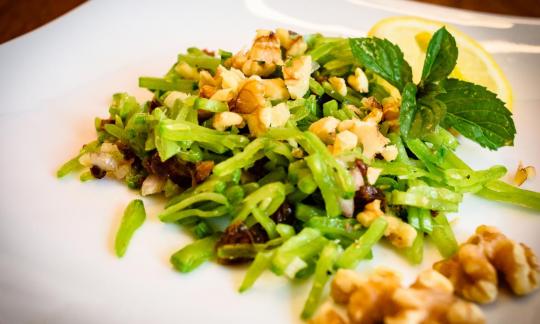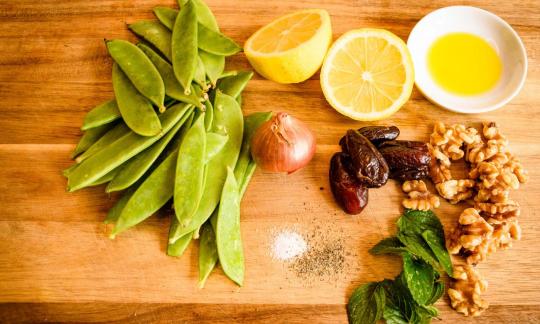Raw sugar snap pea salad with walnuts and dates
raw-vegan
Ingredients (for servings, )
| For the salad | |
|---|---|
| 7 ⅓ oz | Sugar snap peas, edible pods, raw (organic?) |
| ½ | Shallots, raw (organic?) (0.35 oz) |
| 10 leaves | Moroccan mint, raw (organic?) (0.05 oz) |
| For the dressing | |
| 2 tbsp | Lemon juice (raw?, organic?) (0.51 oz) |
| 5 | Dates, variety Deglet Nour, pitted, raw?, (organic?) (1.2 oz) |
| 1 tbsp | Rapeseed oil (canola, HOLL oil, kernel oil), cold pressed?, organic? (0.49 oz) |
| 1 dash | Table salt (table salt, raw?, organic?) (0.01 oz) |
| 1 dash | Black pepper (organic?, raw?) (0.00 oz) |
| topping | |
| 1 ¾ oz | Walnuts (tree nuts), raw (organic?) |
Equipment
- citrus juicer (lemon squeezer)
Type of preparation
- chop or grind
- food preparation without heating
- squeeze
- remove the skin
Preparation
For the salad
Wash the sugar snap peas and cut them diagonally into very fine strips. Cut half of a shallot into fine cubes.
Wash the mint and chop finely. Put everything in a bowl.To cut the sugar snap peas, it is best to use a long, very sharp knife; this makes it easier.
You can also use spearmint instead of Moroccan mint.
For the dressing
For 4 portions, squeeze about half a lemon. Finely chop the dates. Mix the appropriate amount of freshly squeezed lemon juice with chopped dates, rapeseed oil, salt and pepper.Instead of rapeseed oil, you can use linseed oil, or combine both.
Finishing the salad
Pour the dressing over the salad and mix well.
Roughly chop the walnuts and sprinkle over the salad.
|
Nutritional Information per person
Convert per 100g
|
2000 kcal | |
|---|---|---|
| Energy | 162 kcal | 8.1% |
| Fat/Lipids | 12 g | 16.9% |
| Saturated Fats | 1.0 g | 5.2% |
| Carbohydrates (inc.dietary fiber) | 13 g | 4.8% |
| Sugars | 8.2 g | 9.2% |
| Fiber | 3.0 g | 11.9% |
| Protein/Albumin | 3.6 g | 7.2% |
| Cooking Salt (Na:41.6 mg) | 106 mg | 4.4% |
| Essential micronutrients with the highest proportions | per person | 2000 kcal | |
|---|---|---|---|
| Fat | Alpha-Linolenic acid; ALA; 18:3 omega-3 | 1.5 g | 73.0% |
| Fat | Linoleic acid; LA; 18:2 omega-6 | 5.5 g | 55.0% |
| Vit | Vitamin C (ascorbic acid) | 32 mg | 40.0% |
| Min | Manganese, Mn | 0.59 mg | 29.0% |
| Min | Copper, Cu | 0.26 mg | 26.0% |
| Vit | Vitamin K | 16 µg | 21.0% |
| Vit | Folate, as the active form of folic acid (née vitamin B9 and | 37 µg | 18.0% |
| Prot | Tryptophan (Trp, W) | 0.04 g | 15.0% |
| Prot | Valine (Val, V) | 0.24 g | 15.0% |
| Prot | Threonine (Thr, T) | 0.13 g | 14.0% |
Detailed Nutritional Information per Person for this Recipe
The majority of the nutritional information comes from the USDA (US Department of Agriculture). This means that the information for natural products is often incomplete or only given within broader categories, whereas in most cases products made from these have more complete information displayed.
If we take flaxseed, for example, the important essential amino acid ALA (omega-3) is only included in an overarching category whereas for flaxseed oil ALA is listed specifically. In time, we will be able to change this, but it will require a lot of work. An “i” appears behind ingredients that have been adjusted and an explanation appears when you hover over this symbol.
For Erb Muesli, the original calculations resulted in 48 % of the daily requirement of ALA — but with the correction, we see that the muesli actually covers >100 % of the necessary recommendation for the omega-3 fatty acid ALA. Our goal is to eventually be able to compare the nutritional value of our recipes with those that are used in conventional western lifestyles.
| Essential fatty acids | per person | 2000 kcal |
|---|---|---|
| Alpha-Linolenic acid; ALA; 18:3 omega-3 | 1.5 g | 73.0% |
| Linoleic acid; LA; 18:2 omega-6 | 5.5 g | 55.0% |
| Essential amino acids | per person | 2000 kcal |
|---|---|---|
| Tryptophan (Trp, W) | 0.04 g | 15.0% |
| Valine (Val, V) | 0.24 g | 15.0% |
| Threonine (Thr, T) | 0.13 g | 14.0% |
| Isoleucine (Ile, I) | 0.17 g | 13.0% |
| Leucine (Leu, L) | 0.27 g | 11.0% |
| Lysine (Lys, K) | 0.16 g | 9.0% |
| Phenylalanine (Phe, F) | 0.14 g | 9.0% |
| Methionine (Met, M) | 0.04 g | 4.0% |
| Vitamins | per person | 2000 kcal |
|---|---|---|
| Vitamin C (ascorbic acid) | 32 mg | 40.0% |
| Vitamin K | 16 µg | 21.0% |
| Folate, as the active form of folic acid (née vitamin B9 and | 37 µg | 18.0% |
| Vitamin B6 (pyridoxine) | 0.17 mg | 12.0% |
| Thiamine (vitamin B1) | 0.12 mg | 11.0% |
| Pantothenic acid (vitamin B5) | 0.51 mg | 9.0% |
| Biotin (ex vitamin B7, H) | 4.4 µg | 9.0% |
| Vitamin E, as a-TEs | 0.90 mg | 8.0% |
| Vitamin A, as RAE | 49 µg | 6.0% |
| Riboflavin (vitamin B2) | 0.07 mg | 5.0% |
| Niacin (née vitamin B3) | 0.57 mg | 4.0% |
| Essential macroelements (macronutrients) | per person | 2000 kcal |
|---|---|---|
| Phosphorus, P | 77 mg | 11.0% |
| Potassium, K | 228 mg | 11.0% |
| Magnesium, Mg | 37 mg | 10.0% |
| Calcium, Ca | 39 mg | 5.0% |
| Sodium, Na | 42 mg | 5.0% |
| Essential trace elements (micronutrients) | per person | 2000 kcal |
|---|---|---|
| Manganese, Mn | 0.59 mg | 29.0% |
| Copper, Cu | 0.26 mg | 26.0% |
| Iron, Fe | 1.6 mg | 11.0% |
| Zinc, Zn | 0.56 mg | 6.0% |
| Selenium, Se | 1.3 µg | 2.0% |
| Fluorine, F | 0.01 µg | < 0.1% |
| Iod, I (Jod, J) | 0.38 µg | < 0.1% |
The raw sugar snap pea salad with walnuts and dates is quick to prepare, delicious and healthy.
Nutrient profile: According to GDA guidelines, one portion of this recipe covers ¾ of the average daily requirement of omega-3 fatty acids. Vitamin C and the essential trace elements manganese and copper are covered by more than ¼. The ratio of omega-6 to omega-3 fatty acids is 4:1, below the maximum recommended ratio of 5:1. More on this under: Vegans often eat unhealthily. Avoidable nutritional errors.
Sugar snap peas (sweet peas): Sugar snap peas are a type of pea from the legume family. The tender sugar snap peas are usually eaten with their pods. They taste similar to peas, but are a little sweeter and juicier. They can be eaten not only cooked, but also raw, for example in a salad. Like peas in general, they do not contain phasin like other legumes, which, when eaten raw in large quantities, causes damage to blood cells and the intestinal wall. Some pods have threads that must be removed before use. To do this, simply cut off the ends of the pod and pull off the threads. Since fresh pods do not keep for long, they should be eaten quickly.
Shallots: Shallots have a finer, less spicy, sweeter and spicier flavor than most types of onions, which is best when used raw.
Mint: Moroccan mint is a derivative of spearmint. It has a milder taste than peppermint and is particularly suitable for use in food. Moroccan mint has a slightly peppery taste and a minty, fresh, sweet scent. It contains little menthol compared to most other mints, especially peppermint, but provides a very good mint aroma (one reason why we chose this type of mint).
Walnut: The real walnut, also called tree nut, has the highest content of alpha-linolenic acid (an omega-3 fatty acid that is healthy for the heart) of all nuts. They are also rich in vitamin E, zinc (an important trace element for the liver and hair, among other things) and potassium (for the heart muscle, among other things).
Soak the dates: You can also soak the dates beforehand so that they mix better with the sauce. Otherwise, chop the dates as finely as possible.
Mint: Instead of Moroccan mint, you can use green mint. Peppermint contains significantly more menthol, which would be too strong in this salad.
Flaxseed oil: Instead of rapeseed oil, you can use flaxseed oil, or combine both. This improves the fatty acid ratio in favor of omega-3 fatty acids.






